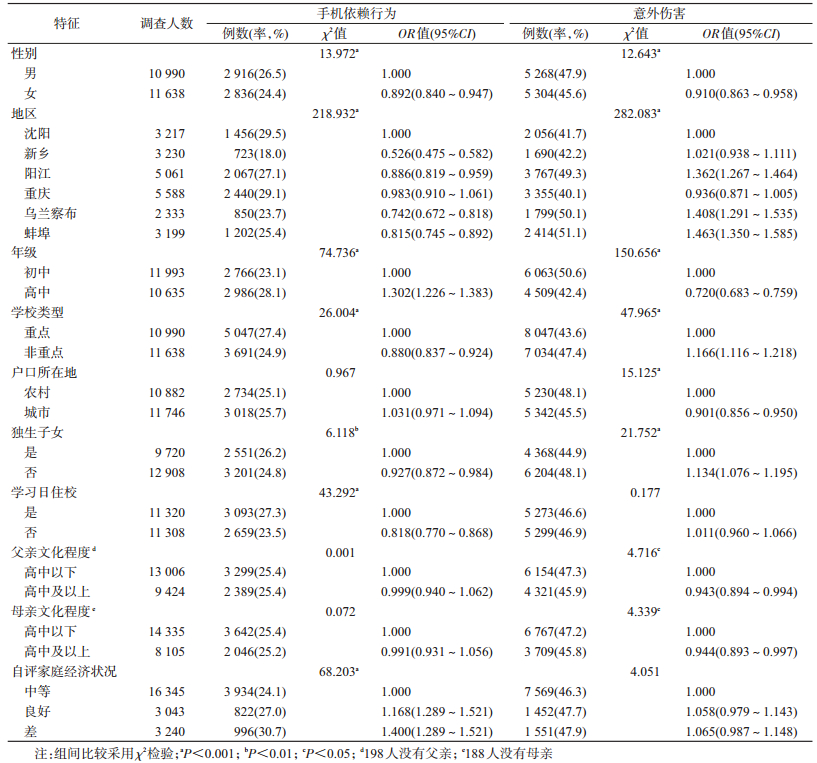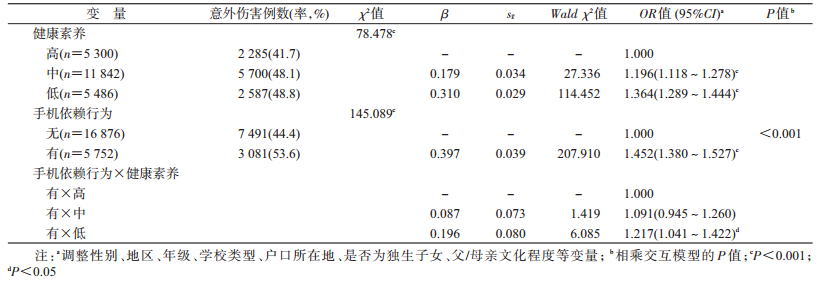文章信息
- 张诗晨, 杨蓉, 李丹琳, 王锦, 万宇辉, 许韶君, 徐洪吕, 马双双, 王伟, 曾寒君, 徐慧琼, 陶芳标.
- Zhang Shichen, Yang Rong, Li Danlin, Wang Jin, Wan Yuhui, Xu Shaojun, Xu Honglyu, Ma Shuangshuang, Wang Wei, Zeng Hanjun, Xu Huiqiong, Tao Fangbiao.
- 中学生健康素养和手机依赖行为的交互作用与意外伤害的关联
- Interactive effects between health literacy and mobile phone dependence as well as its relation with unintentional injuries in middle school students
- 中华流行病学杂志, 2018, 39(12): 1549-1554
- Chinese Journal of Epidemiology, 2018, 39(12): 1549-1554
- http://dx.doi.org/10.3760/cma.j.issn.0254-6450.2018.12.003
-
文章历史
收稿日期: 2018-07-11
2. 230032 合肥, 人口健康与优生安徽省重点实验室;
3. 230032 合肥, 安徽医科大学公共卫生学院2014级预防医学(妇幼专业)专业
2. Anhui Provincial Key Laboratory of Population Health & Aristogenics, Hefei 230032, China;
3. Grade 2014 of Preventive Medicine(Maternal, Child and Adolescent Health Specialty), School of Public Health, Anhui Medical University, Hefei 230032, China
目前,意外伤害已成为儿童青少年伤残和死亡的主要原因,排在10~19岁青少年死亡原因的前十位[1]。我国中学生意外伤害发生率在15%~50%之间[2-3],严重影响青少年的身心健康。健康素养和手机依赖行为与意外伤害的独立关联已经被多数研究所报道[4-6],但健康素养和手机依赖行为的交互作用对意外伤害影响的研究尚不多见。本研究通过对我国6城市中学生的问卷调查,分析健康素养和手机依赖行为的交互作用与意外伤害的关联,为青少年意外伤害的防控提供参考依据。
资料与方法1.研究对象:2015年11月至2016年1月选择辽宁省沈阳市、安徽省蚌埠市、河南省新乡市、内蒙古自治区乌兰察布市、重庆市和广东省阳江市6座城市,采用分层整群抽样方法,在每座城市抽取重点初中、普通初中、省示范高中、市示范高中各1所,以及农村普通初中2所、普通高中和市级示范高中各1所,初一至高三每个年级整群抽取4~6个班级进行调查。共收回问卷23 137份,排除漏填的问卷,共纳入有效问卷为22 628份,有效应答率为97.8%。学生年龄(15.36±1.79)岁。本研究取得学生家长和学校老师的知情同意,并通过安徽医科大学伦理委员会审查(批准号:20140087)。
2.调查内容与方法:①社会人口统计学特征:主要包括性别、年级(初中、高中)、户口所在地(农村、城市)、是否独生子女、学习日是否住校、父、母亲文化程度(高中以下、高中及以上)及自评家庭经济状况(差、中等、良好)等。②健康素养评定:采用《中国青少年互动性健康素养问卷》(Chinese Adolescent Interactive Health Literacy Questionnaire,CAIHLQ)[7]评价青少年健康素养水平,总问卷的Cronbach α系数为0.937,各维度的Cronbach α系数为0.752~0.898[7]。问卷包括6个维度(体力活动、人际关系、压力管理、精神成长、健康意识和营养)31个条目,每个条目赋值1~5分:1=最近6个月没做也没想做;2=最近6个月没做但想做;3=最近1个月内做过但没有规律;4=最近6个月内经常做;5=一直都这样做且超过6个月。根据各条目的得分计算总得分,分数越高表示健康素养水平越高。本研究中根据总得分的百分位数(< P25、P25~P75和 > P75)将其分为低、中和高3组[8-9]。本研究中,CAIHLQ的Cronbach α系数为0.910,各维度的Cronbach α系数在0.662~0.847之间。③手机依赖行为评定:采用《青少年手机使用依赖自评问卷》(Self-rating Questionnaire for Adolescent Problematic Mobile Phone Use,SQAPMPU)对手机依赖行为进行评定[10]。总问卷的Cronbach α系数为0.870,各维度的Cronbach α系数在0.580~0.830之间。问卷包括戒断症状、渴求性症状和身心影响3个维度13个条目,每个条目赋值1~5分,即从不、偶尔、有时、经常、总是。本研究中以手机依赖总分的P75作为划界,分为有(≥P75)与无(< P75),了解学生手机依赖行为[11-12]。本研究SQAPMPU的Cronbach α系数为0.930,各维度的Cronbach α系数在0.711~0.879之间。④意外伤害评定:参照中华人民共和国国家标准——儿童少年伤害监测方法[13],将意外伤害分为道路交通事件、挤压、坠落及绊倒、擦伤及刮蹭、刺伤或割伤、咬伤及扎伤、爆炸力冲击、封闭的缺氧空间、淹溺水、触电、化学品或其他物质中毒及其他伤害12种。凡在近1年内,到医院/校医室诊治;或家长/老师/自己做紧急处理;或受伤后休息1 d以上3种情况中,出现1种情况者判定为有意外伤害。本研究中,意外伤害问卷的Cronbach α系数为0.724。
3.统计学分析:采用EpiData 3.0软件进行录入、SPSS 23.0软件进行统计学分析。采用χ2检验比较不同组间中学生手机依赖行为和意外伤害检出率;交互作用分析中将健康素养和手机依赖行为作为2个交互项,建立logistic回归模型,调整关键的人口统计学变量,模型纳入乘积项的方法来评价相乘交互作用,模型P < 0.05则提示存在相乘交互作用;当OR > 1及其95%CI的上限和下限均 > 1则提示健康素养和手机依赖行为对意外伤害存在正向相乘交互作用。检验水准α=0.05。
结果1.中学生手机依赖行为和意外伤害的检出率:中学生手机依赖行为检出率为25.4%。男生、高中生、重点学校学生、独生子女、住校生、家庭经济状况差的学生,手机依赖行为检出率高于对照组,差异均有统计学意义(均P < 0.01)。此外,沈阳地区中学生手机依赖行为的检出率最高(29.5%),其次是重庆(29.1%)和阳江地区(27.1%)。见表 1。
中学生意外伤害检出率为46.7%。男生、初中生、非重点学校学生、农村学生、非独生子女和父/母亲文化程度高中以下的学生,意外伤害检出率高于对照组,差异均有统计学意义(均P < 0.05)。此外,蚌埠地区中学生意外伤害的检出率最高(51.1%),其次是乌兰察布(50.1%)和阳江地区(49.3%)。见表 1。
2.中学生健康素养、手机依赖行为对意外伤害的独立作用和相乘交互作用:logistic回归模型显示,在调整性别、年级、户口所在地、是否为独生子女、父/母亲文化程度等变量后,中、低水平健康素养和手机依赖行为均与中学生意外伤害正向关联。同时,相乘交互作用logistic回归模型拟合度良好(P < 0.001),健康素养和手机依赖行为对意外伤害存在正向相乘交互作用。见表 2。
本研究结果显示,中学生意外伤害的检出率为46.7%,高于余小鸣等[14]的研究结果(15.53%),但与杨剑等[2](49.41%)和顾璇等[15]的研究结果(43.3%)相近。学生意外伤害检出率普遍较高原因是多方面的,如学生本身的气质及生物学特征、社会环境因素中父母教养方式及家庭环境等[16-17]。男生意外伤害的检出率高于女生,这与男生喜欢参加刺激冒险的活动,或者与老师和家长对男女生教育和保护方式的不同有关。初中生意外伤害检出率高于高中生,可能是随着年龄的增长,接受教育水平的提高,对如何预防意外伤害的能力也随之提高[18]。结果显示,父、母亲文化程度较低和非独生子女学生意外伤害检出率高于对照组学生,这可能与父母本身条件状况、家庭中子女较多而缺乏对子女的关注及教育有关[19]。农村中学生意外伤害的检出率高于城市中学生,与已有研究结果相似[20],这可能与农村父母外出务工、对农村学生的安全重视程度和管教等不如城市学生有关[21]。而学生在校内外不规范的活动所造成的意外伤害也是不容忽视的因素,如体育活动前未做好准备活动、缺乏应有的保护措施等[22]。因此,除了鼓励学生积极参加各类体育运动,还应向其讲授正确的运动知识与技能,预防运动过程中的意外伤害。健康素养与中学生意外伤害的发生密切相关。与高健康素养相比,中、低水平的健康素养是意外伤害的危险因素,这与本课题组之前的研究结果一致[23]。健康素养水平可直接影响个体的健康相关行为,如减少意外伤害行为的发生,或间接影响心理健康,进而影响意外伤害的发生。
当前,全球范围内手机使用已经成为一个普遍现象,根据2012年5月Google调查结果Our Mobile Planet网站上公布,全球智能手机用户在过去7 d内每天都使用手机的概率超过50%,其中日本高达77%。青少年手机依赖的现象也较为常见,日本高中生平均每周手机使用时间为24 h[24]。Lopez-Fernandez等[25]用手机使用问题问卷(PMPUQ)对欧洲地区2 275名青年进行的研究发现,欧洲地区北部和南部青年手机使用量最大(PMPUQ=11.43,12.52),其中电子邮件(69.2%,68.2%)、网络聊天(65.6%,79.3%)和访问社交网络平台(64.6%,72.2%)的比例最高;而比利时(3.9%)、英国(3.5%)和法国(3.4%)青年手机高度依赖的比例高于其他欧洲地区。印度中学生手机依赖检出率为31.33%[26],略高于本次调查的中学生手机依赖行为检出率(25.4%),而使用SQAPMPU对中国大学生的调查发现,手机依赖检出率为28.2%[11],与本研究结果相近。这与本研究所使用的问卷评判标准有关,SQAPMPU考察调查对象戒断症状、渴求性症状和身心影响3个方面的内容,而不单单是对手机使用量多少的评判,因此本研究手机依赖行为的检出率略低于其他研究。多项研究发现手机依赖行为可能降低使用者的关注力,增加道路碰撞、擦伤或跌落等意外伤害的发生率[12, 27]。同时,青少年长期使用手机可显著增加焦虑、抑郁、攻击等不良心理和行为问题的发生[28-29]。Tao等[11]的研究发现,手机依赖和心理问题的交互作用会增加中学生发生碰撞(车辆或行人)、跌倒的风险。由此可见,手机依赖的现象已不容忽视,而手机依赖行为可直接影响意外伤害,或与其他相关因素联合影响意外伤害的发生。
多因素logistic回归分析结果显示,低水平健康素养中学生意外伤害和手机依赖行为的检出率均高于中、高水平健康素养中学生,同时,健康素养和手机依赖对意外伤害的发生存在正向相乘交互作用,从相乘、相加交互作用的概念上可以推论出对应的相加交互作用应该也有统计意义[30]。潘金仁和陈坤[31]的研究结果也显示,相乘交互作用为无或正值时,按加法模型均判断存在正交互作用,相乘交互作用为负值时,按加法模型判断则各种可能性均存在。因此,健康素养和手机依赖对意外伤害存在交互作用,提示可通过提高中学生健康素养水平,减少手机使用来预防意外伤害的发生,其中的机制还需进一步验证。
本研究数据来源于6个地区的中学生,样本人群相对较大。此外,本研究是探讨中学生健康素养水平和常见的手机依赖行为与意外伤害之间的关联,对青少年伤害的防控提供了理论依据,具有现实意义。本研究存在局限性。首先,本次研究数据来源于中学生的自我报告,可能存在信息误差;其次,本研究采用横断面调查,结果不能证实因果关联,未来需要纵向的队列研究来阐明其因果关系。
综上所述,通过提高中学生健康素养,同时干预手机使用行为,可降低中学生意外伤害的发生率。
志谢 感谢在现场数据采集过程中参与工作的学校工作人员及项目团队成员和学生们
利益冲突 无
| [1] |
World Health Organization. Health for the world's adolescents: A second chance in the second decade[EB/OL].[2018-07-03]. http://www.who.int/maternal_child_adolescent/documents/second-cade/en/.
|
| [2] |
杨剑, 刘晓玲, 周亚敏, 等. 澳门地区中学生伤害现况及影响因素分析[J]. 中国公共卫生, 2014, 30(1): 98-101. Yang J, Liu XL, Zhou YM, et al. Incidence and influencing factors of injury among middle school students in Macao[J]. Chin J Public Health, 2014, 30(1): 98-101. DOI:10.11847/zgggws2014-30-01-30 |
| [3] |
汤建军, 郝加虎, 韩慧, 等. 蚌埠市中学生手机使用依赖与伤害发生的关系[J]. 中国学校卫生, 2016, 37(2): 208-211. Tang JJ, Hao JH, Han H, et al. Relationship between mobile phone dependence and injury among Bengbu middle school students[J]. Chin J Sch Health, 2016, 37(2): 208-211. DOI:10.16835/j.cnki.1000-9817.2016.02.015 |
| [4] |
Byington KW, Schwebel DC. Effects of mobile Internet use on college student pedestrian injury risk[J]. Accid Anal Prev, 2013, 51: 78-83. DOI:10.1016/j.aap.2012.11.001 |
| [5] |
Zhao N, Reimer B, Mehler B, et al. Self-reported and observed risky driving behaviors among frequent and infrequent cell phone users[J]. Accid Anal Prev, 2013, 61: 71-77. DOI:10.1016/j.aap.2012.07.019 |
| [6] |
Institute of Medicine (US) Committee on Health Literacy. Health literacy:a prescription to end confusion[M]. Washington, DC: The National Academies Press, 2004.
|
| [7] |
张诗晨, 万宇辉, 陶舒曼, 等. 中国青少年互动性健康素养问卷的信度和结构效度评价[J]. 中国学校卫生, 2014, 35(3): 332-336. Zhang SC, Wan YH, Tao SM, et al. Reliability and construct validity of the Chinese adolescent interactive health literacy questionnaire[J]. Chin J Sch Health, 2014, 35(3): 332-336. |
| [8] |
Zhang SC, Tao FB, Wu XY, et al. Low health literacy and psychological symptoms potentially increase the risks of non-suicidal self-injury in Chinese middle school students[J]. BMC Psychiatry, 2016, 16: 327. DOI:10.1186/s12888-016-1035-y |
| [9] |
张诗晨, 杨蓉, 万宇辉, 等. 中国六座城市中学生健康素养与意外伤害发生的关系[J]. 中国学校卫生, 2018, 39(2): 185-188, 192. Zhang SC, Yang R, Wan YH, et al. Association of health literacy and unintentional injurious among Chinese middle school students in six cities[J]. Chin J Sch Health, 2018, 39(2): 185-188, 192. DOI:10.16835/j.cnki.1000-9817.2018.02.009 |
| [10] |
陶舒曼, 付继玲, 王惠, 等. 青少年手机使用依赖自评问卷编制及其在大学生中的应用[J]. 中国学校卫生, 2013, 34(1): 26-29. Tao SM, Fu JL, Wang H, et al. Development of self-rating questionnaire for adolescent problematic mobile phone use and the psychometric evaluation in undergraduates[J]. Chin J Sch Health, 2013, 34(1): 26-29. |
| [11] |
Tao SM, Wu XY, Zhang YK, et al. Effects of sleep quality on the association between problematic mobile phone use and mental health symptoms in Chinese college students[J]. Int J Environ Res Public Health, 2017, 14(2): E185. DOI:10.3390/ijerph14020185 |
| [12] |
Tao SM, Wu XY, Wan YH, et al. Interactions of problematic mobile phone use and psychopathological symptoms with unintentional injuries:a school-based sample of Chinese adolescents[J]. BMC Public Health, 2016, 16: 88. DOI:10.1186/s12889-016-2776-8 |
| [13] |
中华人民共和国国家质量监督检验检疫总局, 中国国家标准化管理委员会. GB/T 31180-2014儿童青少年伤害监测方法[S].北京: 中国标准出版社, 2015. General Administration of Quality Supervision, Inspection and Quarantine of the People's Republic of China, Standardization Administration of the People's Republic of China. GB/T 31180-2014 Methods for injury surveillance among child and adolescent[S]. Beijing: China Standards Press, 2015. |
| [14] |
余小鸣, 张译天, 黄思哲, 等. 青少年意外伤害与健康危险行为的关联研究[J]. 中华行为医学与脑科学杂志, 2017, 26(2): 163-166. Yu XM, Zhang YT, Huang SZ, et al. Relationship between unintentional injury and health risk behaviors among adolescents[J]. Chin J Behav Med Brain Sci, 2017, 26(2): 163-166. DOI:10.3760/cma.j.issn.1674-6554.2017.02.014 |
| [15] |
顾璇, 卞莉, 李红影, 等. 蚌埠市中学生伤害发生现状及其与社会适应的关系分析[J]. 实用预防医学, 2014, 21(9): 1065-1067. Gu X, Bian L, Li HY, et al. Current status of injuries and their correlation with social adaptability among middle school students in Bengbu city[J]. Pract Prev Med, 2014, 21(9): 1065-1067. DOI:10.3969/j.issn.1006-3110.2014.09.013 |
| [16] |
Oldin A, Lundgren J, Norén JG, et al. Individual risk factors associated with general unintentional injuries and the relationship to traumatic dental injuries among children aged 0-15 years in the Swedish BITA study[J]. Dent Traumatol, 2016, 32(4): 296-305. DOI:10.1111/edt.12258 |
| [17] |
He SR, Lunnen JC, Puvanachandra P, et al. Global childhood unintentional injury study:multisite surveillance data[J]. Am J Public Health, 2014, 104(3): e79-84. DOI:10.2105/AJPH.2013.301607 |
| [18] |
Peltzer K, Pengpid S. Factors associated with unintentional injury among university students in 26 countries[J]. Public Health Nurs, 2015, 32(5): 440-452. DOI:10.1111/phn.12179 |
| [19] |
Shi HY, Yang XJ, Huang CP, et al. Status and risk factors of unintentional injuries among Chinese undergraduates:a cross-sectional study[J]. BMC Public Health, 2011, 11: 531. DOI:10.1186/1471-2458-11-531 |
| [20] |
Yiengprugsawan V, Stephan K, McClure R, et al. Risk factors for injury in a national cohort of 87, 134 Thai adults[J]. Public Health, 2012, 126(1): 33-39. DOI:10.1016/j.puhe.2011.09.027 |
| [21] |
Asbridge M, Azagba S, Langille DB, et al. Elevated depressive symptoms and adolescent injury:examining associations by injury frequency, injury type, and gender[J]. BMC Public Health, 2014, 14: 190. DOI:10.1186/1471-2458-14-190 |
| [22] |
Salam RA, Arshad A, Das JK, et al. Interventions to prevent unintentional injuries among adolescents:a systematic review and meta-analysis[J]. J Adolesc Health, 2016, 59(4 Suppl): S76-87. DOI:10.1016/j.jadohealth.2016.07.024 |
| [23] |
张诗晨, 杨蓉, 万宇辉, 等. 中国5省份中学生健康素养与伤害发生的关联分析[J]. 中华预防医学杂志, 2018, 52(8): 785-790. Zhang SC, Yang R, Wan YH, et al. Association of the health literacy and the incidence of injuries among Chinese middle school students in five provinces[J]. Chin J Prev Med, 2018, 52(8): 785-790. DOI:10.3760/cma.j.issn.0253-9624.2018.08.003 |
| [24] |
Ikeda K, Nakamura K. Association between mobile phone use and depressed mood in Japanese adolescents:a cross-sectional study[J]. Environ Health Prev Med, 2014, 19(3): 187-193. DOI:10.1007/s12199-013-0373-3 |
| [25] |
Lopez-Fernandez O, Kuss DJ, Romo L, et al. Self-reported dependence on mobile phones in young adults:a European cross-cultural empirical survey[J]. J Behav Addict, 2017, 6(2): 168-177. DOI:10.1556/2006.6.2017.020 |
| [26] |
Nikhita CS, Jadhav PR, Ajinkya SA. Prevalence of mobile phone dependence in secondary school adolescents[J]. J Clin Diagn Res, 2015, 9(11): VC06-09. DOI:10.7860/jcdr/2015/14396.6803 |
| [27] |
Lin MB, Huang YP. The impact of walking while using a smartphone on pedestrians' awareness of roadside events[J]. Accid Anal Prev, 2017, 101: 87-96. DOI:10.1016/j.aap.2017.02.005 |
| [28] |
Yang YS, Yen JY, Ko CH, et al. The association between problematic cellular phone use and risky behaviors and low self-esteem among Taiwanese adolescents[J]. BMC Public Health, 2010, 10: 217. DOI:10.1186/1471-2458-10-217 |
| [29] |
Wang PW, Liu TL, Ko CH, et al. Association between problematic cellular phone use and suicide:the moderating effect of family function and depression[J]. Compr Psychiatry, 2014, 55(2): 342-348. DOI:10.1016/j.comppsych.2013.09.006 |
| [30] |
邱宏, 余德新, 王晓蓉, 等. Logistic回归模型中交互作用的分析及评价[J]. 中华流行病学杂志, 2008, 29(9): 934-937. Qiu H, Yu DX, Wang XR, et al. Study on the interaction under logistic regression modeling[J]. Chin J Epidemiol, 2008, 29(9): 934-937. DOI:10.3321/j.issn:0254-6450.2008.09.019 |
| [31] |
潘金仁, 陈坤. 队列研究资料相加交互作用可信区间的Bootstrap法估计[J]. 中华流行病学杂志, 2010, 31(7): 808-811. Pan JR, Chen K. Bootstrap method-based estimation on the confidence interval for additive interaction in cohort studies[J]. Chin J Epidemiol, 2010, 31(7): 808-811. DOI:10.3760/cma.j.issn.0254-6450.2010.07.020 |
 2018, Vol. 39
2018, Vol. 39




